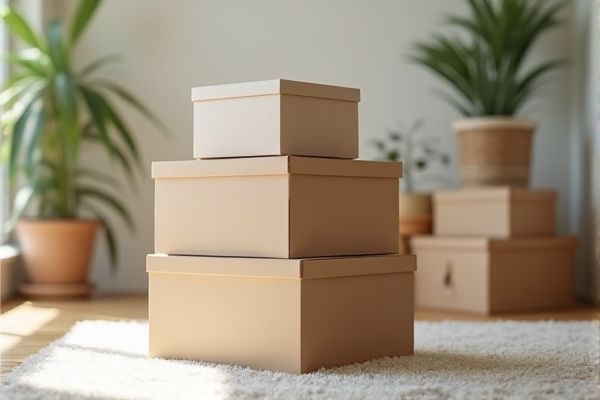
Collapsible boxes save space by folding flat when not in use, making them ideal for efficient storage and transportation, while stackable boxes are designed to securely nest on top of each other, optimizing vertical space for organization and display. Discover how choosing between collapsible and stackable boxes can enhance Your storage solutions by reading the rest of this article.
Table of Comparison
| Feature | Collapsible Box | Stackable Box |
|---|---|---|
| Definition | A container that can expand or collapse to show or hide content. | A container designed to be stacked on top of one another for optimized space. |
| Primary Use | Content toggling and saving screen space dynamically. | Organizing multiple boxes vertically or horizontally in a compact layout. |
| Space Management | Reduces visible content area when collapsed. | Maximizes vertical or horizontal stacking efficiency. |
| Interactivity | User-controlled expand/collapse action. | Static stacking, minimal interactivity. |
| Use Case Examples | FAQs, menus, content sections. | Storage boxes, UI panels, modular layouts. |
| Complexity | Requires scripting for toggle functionality. | Simple structural design. |
| Performance | May impact UI if overly complex or nested. | Generally optimized for layout stability. |
Introduction to Collapsible and Stackable Boxes
Collapsible boxes are designed with foldable panels that enable easy storage and transport by reducing their volume when not in use. Stackable boxes feature rigid structures that allow secure vertical stacking, maximizing space efficiency in warehouses and retail environments. Both types improve logistics, with collapsible options optimizing return logistics and stackable boxes enhancing stability during stacking.
Key Features of Collapsible Boxes
Collapsible boxes feature foldable panels that allow them to be easily flattened for efficient storage and transportation, reducing warehouse space by up to 70%. Their durable construction supports heavy loads while maintaining structural integrity, making them ideal for repeated use. You benefit from quick assembly and disassembly, which boosts operational efficiency in logistics and inventory management.
Key Features of Stackable Boxes
Stackable boxes are designed with sturdy, interlocking edges that enable secure vertical piling without slipping, optimizing warehouse space and improving inventory organization. These boxes are typically made from durable materials such as heavy-duty plastic or reinforced cardboard, ensuring they can support substantial weight and withstand repeated stacking. You benefit from enhanced accessibility and streamlined logistics when using stackable boxes, especially in environments requiring efficient storage and transportation.
Durability and Strength Comparison
Collapsible boxes are designed with reinforced corners and durable materials to withstand repeated folding without compromising structural integrity, making them ideal for moderate loads and frequent storage changes. Stackable boxes feature rigid construction and interlocking designs that enhance load-bearing capacity, providing superior strength for heavy items and stable stacking during transit or storage. Your choice between collapsible and stackable boxes should consider the balance between portability and maximum durability based on the intended use.
Space Efficiency and Storage Solutions
Collapsible boxes offer exceptional space efficiency by folding flat when not in use, significantly reducing storage volume compared to stackable boxes that maintain a fixed shape. Stackable boxes maximize vertical storage capacity and are ideal for stable piling but require more space when empty. Choosing between collapsible and stackable boxes depends on balancing space-saving needs during storage and ease of access during usage.
Ease of Use and Handling
Collapsible boxes offer superior ease of use through simple folding mechanisms that reduce volume when not in use, enabling quick setup and storage without tools. Stackable boxes provide efficient handling by securely interlocking to maintain stability during transport and storage, optimizing space utilization. Both types enhance operational efficiency, with collapsible boxes prioritizing convenience and stackable boxes focusing on secure organization.
Material and Construction Differences
Collapsible boxes are typically made from lightweight yet durable materials such as corrugated plastic or reinforced cardboard designed to fold flat without damage, while stackable boxes are often constructed from rigid, sturdier materials like heavy-duty plastic or solid wood to support weight securely. The construction of collapsible boxes includes hinges or joints that allow easy folding, optimizing storage space when not in use; in contrast, stackable boxes emphasize reinforced corners and interlocking lids to ensure stability and safety during stacking. Your choice between these two depends on whether you prioritize compact storage or maximum load-bearing capacity.
Cost Analysis: Collapsible vs Stackable
Collapsible boxes typically offer significant cost savings by reducing storage and shipping expenses due to their ability to fold flat, which lowers volumetric freight costs. Stackable boxes, while often more durable and easier to organize in warehouses, usually incur higher storage fees and transportation costs since they maintain their full size even when empty. Your choice between collapsible and stackable boxes should consider these cost factors alongside your specific logistical needs for maximum efficiency.
Ideal Applications and Use Cases
Collapsible boxes are ideal for seasonal businesses, retail storage, and transportation where space-saving is critical during off-use periods. Stackable boxes excel in warehouses, inventory management, and distribution centers where stable stacking optimizes vertical space and ensures easy access. Your choice depends on whether flexibility for storage or durable stacking for organized inventory is the primary need.
Choosing the Right Box for Your Needs
Choosing the right box for your needs depends on storage space, durability, and ease of use. Collapsible boxes save space when not in use, making them ideal for temporary storage or frequent transport, while stackable boxes provide sturdy, secure stacking for long-term organization or warehouse use. Consider your priorities for convenience and stability to select the most efficient solution for your storage requirements.
 homyna.com
homyna.com